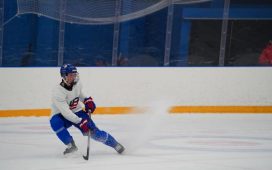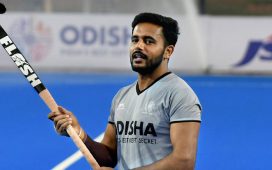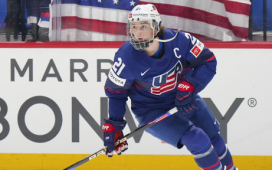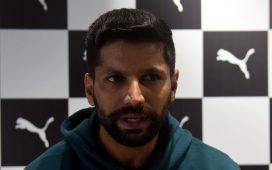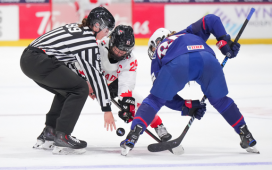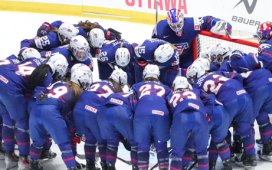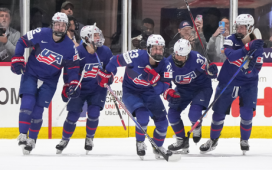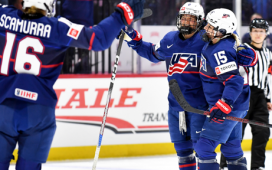“Do you believe in miracles?” Perhaps no phrase is as synonymous with hockey as the one Al Michaels exclaimed in the closing moments of the 1980 Winter Olympics game between the United States and the Soviet Union. The U.S. team, comprised mainly of collegiate players, beat the powerful Soviet squad 4-3. Two days later, the U.S. defeated Finland to win the gold medal. But it was the game against the Soviet Union – the ‘Miracle on Ice’ game – that is best remembered 40 years later. The contest has been the subject of several documentaries over the years and a made-for-TV movie in 1981. But it was in 2004, when Disney released Miracle, that the world gained its best film about the sport’s ultimate David-and-Goliath story.
Miracle is not just a great dramatization of that game – it is one of the greatest hockey movies ever made because of the ever appealing story of the underdog coming out on top and for its realistic action sequences that featured real hockey players. Instead of finding actors, teaching them a bit of skating and then editing closeups with cutaway shots of doubles, Miracle bucked the trend by finding actual players and then teaching them how to act. Here’s the story, directly from the people behind the film, of how it all came together.
Director Gavin O’Connor and cinematographer Dan Stoloff are hired and begin pre-production.
DAN STOLOFF: (Cinematographer) Gavin O’Connor and I had done a movie a couple of years before called Tumbleweeds, which we had made for very little money, sold it at Sundance and it became a hit. He was hired to direct Miracle and brought me along. To his credit, Gavin fought really hard to bring me on. Disney wanted to use someone much more experienced, but Gavin made a case that we had a shorthand and that my work speaks for itself. We were like two novices out there, and we pulled it off.
Hollywood star Kurt Russell is cast as U.S. coach Herb Brooks. Ryan Walter, a veteran of 15 seasons in the NHL, is brought on board to help as a hockey technical advisor. He also plays the referee in the U.S.-Soviet game and works as a stand-in for Russell. O’Connor, Stoloff, Walter and hockey co-ordinator Mark Ellis begin searching for hockey players for the film.

RYAN WALTER: (Hockey Technical Advisor / U.S.-Soviet Game Referee) Mike Johnston, who was the assistant coach with the Vancouver Canucks at the time, was called by Disney because they wanted a hockey expert in the Vancouver area. Mike passed my info along. I had a great talk with the people at Disney. My wife, Jenny, loves movies and urged me to do it. I was involved three months before they started shooting the film.
STOLOFF: Disney did a nationwide casting search. First, they had to be hockey players. And then they had to be able to act. The first part of the casting process was like tryouts. It was purely physical stuff. They culled 4,000 applicants down to about 200. We knew they could really play. The question was if they were confident enough to act.
PATRICK O’BRIEN DEMSEY: (Mike Eruzione) I played hockey in high school. I didn’t play much in college but had a great time. I quit hockey my senior year to focus on academics because I wanted to get out of school. Funny how things work out. I was slacking off at my graphic-design internship one day, trying to figure out what I wanted to do with my life. I thought about going to acting school after I finished college. I started scouring the internet for acting schools and came across a posting for an open casting call in Boston for hockey players. (The next day) was the last day, so I went and read some lines.
KENNETH MITCHELL: (Ralph Cox) I grew up in Canada. I was born into hockey and had its DNA running through my veins. I used to play goalie but hung up my goalie skates when I was 17 and played forward in men’s leagues. I had acted in a couple of made-for-TV movies and TV series and a film called The Recruit. Most of my acting work was based in Toronto. I was moving to L.A. with my girlfriend, now my wife, but I missed the countrywide hockey tests. My manager rented ice, borrowed some goalie gear and shot footage of me playing goal. We submitted the tape to Disney, and they asked me to screen test for the part of Jimmy Craig.
STOLOFF: We cast guys who could really skate. We were given a budget by Disney that allowed us to put on a really big show and take the time we needed to do it right. There are a few stunt guys in there. Some of those hits were stunt guys. But for the most part, what you see is really there. Of course, this was before the days of CGI or digital face replacement or anything like that.
DEMSEY: I ended up auditioning six or seven times. One time was on the ice. It was over the course of a few months. And then in December of 2002, they flew me to L.A. We had a big weekend camp. We had to play hockey. We had a couple of practices and then had to audition.
MITCHELL: They put us up in hotels and split us up into two teams. They ran the weekend like a Jr. A training camp. I was screen testing for Jim Craig. So was Eddie Cahill, who wasn’t a great hockey player but looked exactly like Jimmy Craig. And he was one of the more well-known actors that was auditioning. We were put on opposite teams. I was great at the hockey part, but I could tell that the producers and director and the powers that be were very interested in Eddie. But I didn’t give up. I performed well on the ice. The next day, we were given scenes and had to perform them. I did well. I enjoyed that part of the process.
DEMSEY: Michael Mantenuto, who was cast as Jack O’Callahan, got into a fight during the tryouts. He was just ready to go, and he knuckled this guy pretty good. It was great. He was upset with himself at first and said, “Aw man, I screwed my chances. They don’t want to see this.” But that’s exactly what they wanted. Michael was perfect as O’Callahan. Handsome as can be, an incredible hockey player, and he had an attitude.
MITCHELL: Once the weekend was over, I got a phone call informing me that they hired Eddie Cahill to play Jimmy Craig. But Gavin liked me so much that he wanted to find a different part for me. That’s how Ralphie Cox blossomed. Gavin rewrote some of the script to punch up the character. That moment when Ralphie Cox gets cut, it’s quite emotional. It’s something the audience can all relate to. For that moment to have a payoff, in order to be emotionally invested in that character, we had to fall in love with him in the beginning half of the movie. Gavin wanted me to play the part. I was more than thrilled. It was the first American movie I did since I moved out to L.A.
After the U.S. players are cast, another tryout is held in Vancouver to recruit players for the opposing teams. Several players with NHL experience are hired to be the Soviet players, including Sasha Lakovic (37 games with the Flames and Devils) and Todd Harkins (48 games with the Flames and Whalers).

TODD HARKINS: (Valeri Kharlamov) I retired in 2001 and was pretty miserable in not playing. (See sidebar on at bottom.) My wife saw the casting call in a Vancouver newspaper about open tryouts to be in the movie Miracle. She cut it out and put it on my dinner plate. I was so upset with the game that I crumpled it up and threw it in the garbage. But a couple of days later, I pulled it out of the garbage and decided to go to the Westin Bayshore Hotel in downtown Vancouver. The line was out of the hotel and around the corner! From what I heard, there were over 8,000 people who got in line to get into the tryout. There were guys at the hotel dressed up in hockey gear, with their skate guards on. There were guys with skates slung over their shoulders or with jerseys on. So many guys were trying to be a part of this movie. Once we got through the screening process, 800 players out of 8,000 made it to the ice rink, starting on Monday.
STOLOFF: When we did our research and looked at hockey movies before, there’s never a time when you’re tight on somebody’s skates and you tilt up to see who the actor is. It’s always a cut. Movies like Mystery, Alaska come to mind. And we said, no, we’re going to make sure there is no doubt everyone you see in the movie is actually playing on the ice.
HARKINS: I was in a group of 50 guys on the ice. The first drill, we skate a lap around the rink. Then they line us up and start cutting guys. The next drill, we skated backwards around the rink. Then they lined us up again and cut more guys. We were out there for an hour. We’d start with 50 guys and end up with five. That went on for days. I didn’t know if I was trying out to be on the U.S. team or the Russian team. Nobody said anything. They just kept cutting guys every time we did a drill. They cut us down to about 25 guys for Friday’s skate. There were some pretty good players out there, some former NHL guys and other talented players. At the end of that practice, they cut everyone except 11 of us to play the Soviet Union players.
The remainder that were cast as the Soviet Union team were extras that looked Russian but were paid less to sit on the bench while Harkins and the other 10 players did the on-ice work. Filming took place in Vancouver. One of the biggest challenges in making Miracle was recreating hockey footage from such a famous game. Plays had to be drawn up and then practised over and over again.
STOLOFF: We went through the game footage. We went through every play. The first thing we did was decide which plays we were going to get into the movie. We broke the game down thematically, asked, what is the story being told and how do we tell it efficiently? We spent about four months going over the footage before we shot a frame. We had little toy hockey guys and a little camera, and we basically storyboarded every shot you see in the movie.
MITCHELL: We showed up in Vancouver a month-and-a-half before filming. There was a playbook of over 100 hockey plays that we had to work through and memorize for the filming. In general, I found it a lot easier to be aggressive on offense and be true to offense. But when you’re acting, you have to go against your instincts. For example, you might have to let the puck go through your legs in order for a scene or play to work, but your instincts are to stop that puck. It’s hard to be fully aggressive and make it look real while something like that happens, just for the sake of the movie.
DEMSEY: We were on the ice for six to eight hours a day and then had acting rehearsal at night, to try and work everything out. Then we shot the film for four months.

WALTER: We’re replicating history. So, Mark Johnson’s goal at the end of the first period has to look like Mark Johnson’s goal. We animated the choreographed plays on my computer. We had a very rudimentary program where we built little hockey players, moved them and then played them back. I was always touching up those plays, making sure that the guys understood where they were going, how the play flowed and how it ended. I’d go to center ice with my computer, and we’d practise for quite a while.
STOLOFF: We kept doing it until we got it right. If there was one person in the background not skating at 110 percent, we had to do it again. And as a result, we made the movie we set out to make. In doing that, we developed good relationships with the actual players on the team, Mike Eruzione and Jack O’ Callahan. We would talk with them almost daily. It almost became like we’re making this movie for these guys. And these guys were on the ice and knew exactly what happened. At the end of the day, we did not want to hear them say that we didn’t get things right. We wanted to get it right, and we got it right.
DEMSEY: One of the coolest things happened before we were shooting. We were doing rehearsals. We had white jerseys and full cages on. Nothing to distinguish us from each other. The director calls us over to the boards and introduces us to Herb Brooks! Brooks said, “How you guys doing?” Everyone was quiet, so I said, “You know, we’re a little bit rusty.” And he looks at me and says, “You must be Eruzione then, because he was always a little rusty.” It was just this great moment, where the coach picked me out from everybody.
Six weeks of rehearsal were followed by four months of filming. For many of those cast as U.S. players, this was their first acting experience.
DEMSEY: They brought in hockey players who they thought they might be able to get to act enough to pull it off. Most of us were not actors. We looked enough like the people they wanted us to be. We didn’t know that at the time. We just thought, hey, we’re going to be movie stars.

MITCHELL: I was one of three players in the movie with acting experience. Myself, Eddie Cahill and Nathan West (who played Rob McClanahan) had acted before. The rest of the guys were hockey players, and Gavin was able to mold great performances out of them.
DEMSEY: I had zero training as an actor back then. And there was nothing I could do, at that point, to try and imitate Mike Eruzione without it seeming weird. I didn’t know what I was doing. The director said I was picked for a reason, and all I had to do was get these lines out of my mouth and sound like a coherent human when the camera is rolling (laughs). If I booked an acting job now, I’d study the person’s mannerisms and how they move.
WALTER: The guys that were actors did a great job. Most of the players were not actors, they were hockey players. And the little pieces of acting that they had to do, Gavin and the others would help them out with it.
STOLOFF: Kurt Russell was an amazing coach to these kids because he coached their acting, too. He took it upon himself to drive these kids. For them, it was the most amazing experience they could have, having some guy like that pushing them. And in the end, you feel that, you feel the team in the movie.
DEMSEY: The first thing we shot was the scene outside the bus, when we’re confronting coach Brooks. We needed to be intimidated by him. We were introduced to Kurt, but he kept his distance from us at first. So, going into that first scene, we didn’t know him very well. They had created the perfect moment, because we really were nervous, and that fuelled the scene. Even if we weren’t actually good enough actors to pull off the scene, we were nervous, anyway, because it was our first-ever scene in a movie. And the scene came off beautifully.

HARKINS: Sasha Lakovic was cast as Soviet captain Boris Mikhailov because he looked more Russian than everyone else. Sasha was a character, and he was always in character. Because he was Mikhailov, he had the ‘K’ on his jersey, and he felt that he was the captain of the team. But from an experience standpoint, in the dressing room, I tried to be a leader as well. I remember Sasha came up to me, and he was serious, and he said, “Hey! I’m the captain of this team!” And I said, “Yeah, you wear the ‘K.’ ” One practice, I went on the ice, and someone had sewn a ‘K’ on my jersey. Sasha skates
over to me and says, “Hey! What’s that all about?” I told him he got demoted. We had a good chuckle over it. The crew kept it light in the dressing room because it was long hours and tiring days.
MITCHELL: I was really prepared when we filmed the scene where Ralph Cox gets cut. I didn’t want to f— it up. It felt like an important moment in my career at that point, doing a scene with someone of that stature like Kurt. I like emotional stuff, so I felt very at home. I know that moment, being cut, it felt familiar. We filmed in sequence, so I was leaving shortly after that scene was shot. It felt like art was imitating life, where I was quite sad to be going home, while the rest of the guys got to continue filming. You could feel all of that in the scene. We used that to our advantage.
STOLOFF: I’m an OK skater, not great. Ryan Walter had given me some skating tips. Then one day at lunch, I’m skating around the arena. It had just been resurfaced. I’m going really fast. Suddenly, I catch an edge where the Zamboni had missed a spot, go sprawling and land on my head. I got knocked out. I woke up in a puddle of blood. They rushed me to the hospital, put 14 stitches in my head, and then I was back to work within 45 minutes. And the players looked at me with the big bandage on my head, and I had their respect, because that’s what they do every day. I thought that was cool. I would never had done that on purpose, because it really hurt. But they respected that. That’s what hockey players do.

HARKINS: We’re doing 14- to 16-hour days. It’s hard to do because you were in hockey gear for hours on end. There was a time when a lot of us became very fatigued. Some executives from Disney came and showed us some clips of the movie that they were starting to put together. It really motivated us and got us excited to go out there and continue to work and push through it. We couldn’t believe how real the scenes that they showed us looked. It got us really excited to try and perfect the movie as best we could.
MITCHELL: My favorite scene didn’t make it into the movie. They filmed this great scene where we got the night off, and we go to the bar and let loose. We did this whole disco dance scene on the dance floor. It was fun. Ralphie Cox got to shake a leg. But for timing’s sake, it didn’t make it in.

“Again!” Next to Eruzione’s game-winning goal against the Soviet Union, perhaps the most memorable scene is when coach Brooks bag skates the team after they dog their way to a 3-3 tie with Norway in an exhibition match. The team is forced to skate “Herbies” over and over until Eruzione says his most famous line.
DEMSEY: The scene I’m most happy with is when I say, “I play for the United States of America.” Not because it’s such a pivotal point in the film. It was really a pivotal point in the filming for us. That one scene was shot for three days. We got bag skated for three days. We had some stunt doubles doing some of the bag skating, but we were all just getting creamed for three days.
MITCHELL: It’s a really important part in the movie. Gavin wanted this to be as realistic as possible, so he wanted us to be as tired as we humanly possibly could. We filmed that scene all day, doing the Herbies all day. And those shots of those guys puking, that was all real.
WALTER: There’s no faking it in that scene. The guys were bagged. We had to push them really hard. They knew it. When you’re out of breath, can’t breathe, and have to do it again, it’s never fun. Give the players all the credit. They pushed way beyond what their salary dictated in that moment.
MITCHELL: One of the most magical things about that movie, again, art imitating life, life imitating art, was the moment where Patty had to skate on his own. Gavin wanted Patty to be absolutely exhausted when he delivered that line. So, he made Patty skate on his own to get tired.

DEMSEY: At the end of the third day, we’re shooting the part. They’re bag skating us. Then the director had just me go. Nobody else. So, I do the whole Herbie by myself. I get back to the line, and Gavin has me go again. So, I do another one and get back into line. “Rizzo, go again!”
MITCHELL: So, all of us are watching our dear friend in the trenches, just skating over and over again by himself, until he’s absolutely exhausted. Without anyone saying anything, one guy just starts skating with him. And then two guys started skating. And we’re all looking at each other, and we all started skating, even though we didn’t need to, because the camera wasn’t going to be on us. We’re all skating alongside our brother.
DEMSEY: The guys would not let me get bagged all by myself. They didn’t have to do that, you know. It was a really special moment during the filming that brought us all together, which is what our brilliant director wanted. Because that was the moment that brought the team together in the movie, too.
MITCHELL: There was a real brotherhood that was built in that movie, and I think that part just epitomized that. We were like, “Hey Patty, we’re in this together.” And then, once we were done skating, the cameras started rolling, the closeup is on Patty, and he delivers such a beautiful reading of that line. It was one of my favorite moments in that movie. Every time I see it, it gives me chills.

Since the old fiberglass goalie masks of the time covered the goaltender’s entire face, a goalie stunt double plays Jim Craig for the hockey action scenes. Originally, a Jr. B goalie from Vancouver is hired, but he does not work out as hoped. So, former star NHLer and Conn Smythe Trophy winner Bill Ranford is brought in to help.
HARKINS: For one sequence, I was shooting the puck and missing the net on purpose so the goaltender could deflect the puck into the corner. Gavin got upset and said he wanted me to shoot to score so it looked more realistic. So, we did five takes in a row, and I scored all five times. Gavin was now upset that I was scoring, and that the goalie wasn’t making the save. I told Gavin if he wanted a real goalie, I could get Kirk McLean or Bill Ranford out here. The first one I called was Bill.
BILL RANFORD: (Goalie double for Eddie Cahill, who played Jim Craig) Originally, I had been approached to do the film. To be gone every day for four or five months to do the movie really didn’t fit into my schedule, so I gracefully bowed out. Then, when they filmed the main Jim Craig action scenes, I got a phone call to come back, and they asked if I’d be interested in getting involved in the latter part of it, and that’s when I joined the crew.

WALTER: Bill came in about halfway through the shooting and ends up doing a brilliant job of being Jimmy Craig.
HARKINS: We wanted to make this movie as real as we could. Bill was outstanding. There’s one scene where I run him over and knock him out. That was an intense scene, and we both went at it. We said, “OK, let’s make this real.” And it was real. It wasn’t fun, running the goalie over and over, even though I did it a lot in my career.
RANFORD: The scene where Jim Craig gets run over by Kharlamov, we did that about 20 times. The last time, we missed the timing of it, and Todd caught me with a knee right on the temple. I ended up with a concussion. That wasn’t much fun. I never really had a concussion that bad during my whole playing career. I was back on the ice the next day, but we only had a few days of shooting left.
HARKINS: We convinced Gavin to let us scrimmage a couple of times to get some footage. The 11 Soviet players, we were running out of gas many times, against the 20 U.S. guys. They got some good shots out of that, just us playing and competing hard against each other.
STOLOFF: We have all seen hockey movies where the cameras use long lenses and they’re shooting from up high, like a hockey game. Our whole approach was to put the audience right on the ice with the players. It’s really, really difficult to do that. We had some great camera operators, and we had some great skaters pushing the operators around on these sleds. It was like learning a whole new language, being able to track the action and being involved in the action.
RANFORD: We worked hard to make the scenes realistic. We broke the scenes down, and then we tried to do it with speed and accuracy but also keeping in mind that we wanted to make it as realistic as possible.
HARKINS: One time, Gavin came to us and said we were going to shoot at Bill for two minutes, and whoever scored a goal first would win $1,000 cash. It was just a flurry of shots that they filmed to try and emulate the ending of the real game. We’re going hard, we’re just blasting him, and Bill is standing on his head. And with 15 second left, I scored and got the cash. It never went into my pocket. It went to the guys. I made sure we went out that night and had a good time.
RANFORD: One of my favorite memories was shooting this scene where the puck gets shot in from the blueline and Jim Craig knifes the puck into the crowd. The assistant director comes running out and says to me, “You can’t do that! We have extras in the stands. Someone could get hurt!” The director says “OK, we won’t do it,” but then he asks me to do it again. I point to a “Go USA” sign hanging in the stands and ask him what letter he wants me to hit. The assistant director kept telling me I can’t do that, while the director keeps whispering in my ear, “One more take.” I think we did it three times before we got enough footage of it.
WALTER: To thank me for my work on the hockey sequences, Gavin made me the referee in the big game between the U.S. and the Soviet Union. I ended up with four lines in the movie. Not very hard lines. It was a wonderful experience.

Filming Eruzione’s game-winning goal was challenging for Demsey because it had to look right, all while wearing 25-year-old equipment. In fact, most players had to adapt to the antiquated gear.
DEMSEY: We had some great hockey players in the film. It worked perfectly for the story that I was in the lower tier of ability within the group. And then they had us use these replica wooden sticks. For someone who doesn’t have great hands, they’re not tremendous pieces of equipment. Then I had to be in the right place and score the goal.
HARKINS: We had to use old wooden sticks. All wood, no fiberglass, because they wanted it to be authentic. To be able to try and stickhandle and shoot the puck with wooden sticks they would have used back in 1980 was difficult.
RANFORD: The biggest issue I had with the old equipment was sometimes keeping the puck in my glove. And I was wearing the old deer-hair pads, so they’d get soaked and wouldn’t dry, and then they were heavy to lug around.
DEMSEY: There was a lot of pressure for me to score that game-winning goal. I got it on the third take, which was such a relief for me. Even when I missed the shot, they wanted me to celebrate, so they’d have more celebration footage. But it just didn’t feel right to celebrate when I missed. I felt that they were frustrated with me because I wasn’t celebrating enough, but it didn’t feel right. And then I hit it on the third try, and it was a massive celebration, which felt so good. That was the most pressure I felt during the whole movie, having to perform that specific part and try to capture history and make it feel authentic.
HARKINS: It was so exciting because we were doing something that I had seen as a kid. Growing up in Cleveland and watching the U.S. team when I was a kid made me give up other sports because I wanted to be a hockey player. I wanted to be one of those guys because they paved the path for a lot of American hockey players to make it into the NHL. I wanted to do it justice and try to make sure the hockey scenes looked as real as we could make it.
Miracle is released in theaters on Feb. 6, 2004, nearly 24 years after the Miracle on Ice game took place. The film, with a budget of $28 million, takes in $19 million its opening weekend and a total of $64.5 million during its theatrical run. The movie is well-received by critics and hockey fans alike and routinely ranks at or near the top of “best hockey movies” and “best sports movies” lists.
DEMSEY: My wife is an actress who has worked in the industry for 20 years, and she tells me that people will see her stuff and soon forget about it. But every year, hockey season comes around, and people are watching Miracle. Every four years, the Olympics come around, and people are talking about it again.
MITCHELL: For me to marry my past athletic self with my current profession of acting was a dream come true.
WALTER: We’re very proud of the hockey in Miracle because it’s authentic. And I’m always proud of Disney for making a hockey movie that doesn’t have a lot of swearing in it.
DEMSEY: There’s about five of us players that still live in L.A. Eddie Cahill is still there. Ken Mitchell and my buddy Sam Skoryna, who played goalie Steve Janaszak, and Eric Peter-Kaiser, who played Mark Johnson. We get together with the wives now and then.
RANFORD: Sometimes hockey movies are considered hokey, and our big goal for doing this movie was to make it as realistic as possible. And I think Miracle is one of the best hockey movies done to date.
HARKINS: Miracle catapulted my hockey movie career. I was the hockey director on Slap Shot 3 and The Tooth Fairy and for the TV series A Million Little Things. I’ve done various hockey commercials in Vancouver. I got my name out there in the movie industry because of Miracle.
DEMSEY: I went to school for graphic design. I always loved art. But I really fell in love with the process of filmmaking when working on Miracle. If you’re not going to be an NHL player who goes to the Hall of Fame, what better place to land than a movie that lasts forever about the greatest sporting event in U.S. history? It’s the best place to land if you’re a hockey player, because it never goes away.
A Miracle Within Miracle
Todd Harkins had given up on hockey. The 11-year pro, who played 48 games in the NHL and appeared in three world championships for the U.S., was playing in Europe in 2001. Then, his family got terrible news.
Harkins’ five-year old son, Nicklas, was diagnosed with Mucopolysaccharidosis (MPS) Type 1, a rare enzyme disorder. Doctors told Harkins that Nicklas wouldn’t live past age 10, so Harkins moved back to Vancouver to take care of his son. “Anyone would quit what they’re doing to take care of their children, and I did,” Harkins said. “Instead of blaming the illness, I blamed the game of hockey. I was bitter. I couldn’t get a minor-league contract in North America. I couldn’t find a junior job to coach. That’s why I felt sour about the game.”
It was in 2002 when Harkins’ wife, Kirsten, found the Miracle casting call in a local newspaper. He crumpled it up and threw it in the garbage. A few days later, Harkins, originally from Cleveland, had second thoughts. “Watching the U.S. team win in 1980 was so instrumental to me as a young boy,” he said. “I gave up football and baseball and wanted to be a hockey player.”
Harkins, who hadn’t touched his skates since retirement, tried out for the film and was cast as Soviet Union player Valeri Kharlamov. “Director Gavin O’Connor heard the story about Nicklas,” Harkins said. “My family came to the set one day, and Nicklas skated out on the ice with me dressed in a Kharlamov jersey and got to score on the goalies.”
That day, everyone on set – including several thousand extras – put $2 in a raffle. Everyone wrote “Nicklas Harkins” on their tickets. Harkins donated the $5,000 prize to the Canadian MPS Society. Several Miracle actors, including Eddie Cahill, participated in a charity game called the MPS Cup, with Disney donating some Miracle memorabilia.
Shortly after the movie’s release in 2004, a synthetic enzyme called Aldurazyme was approved in Canada. Nicklas, then eight, received his first treatment. Now 24 and finishing college, he gets the synthetic enzyme once a week. “You tie Miracle in with our family, Nicklas and his situation, and it all just happened around the same time,” said Harkins, who currently works as a high-school hockey coach. “It was a pretty special time. It motivated me to be back in the game.”
